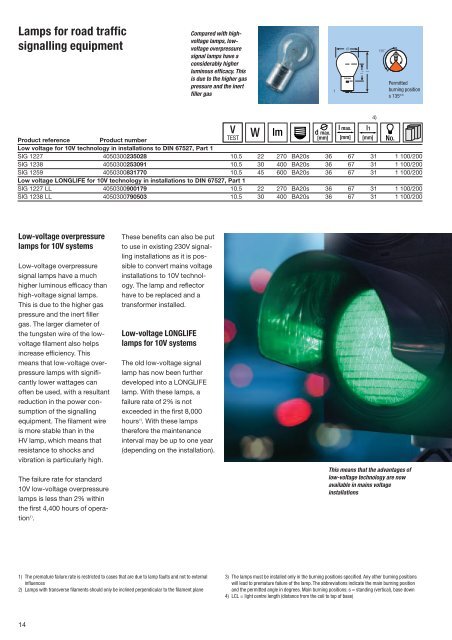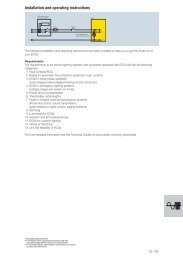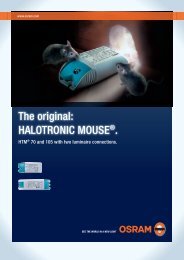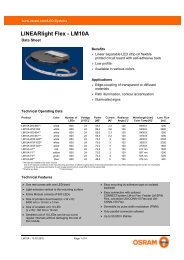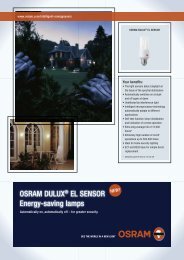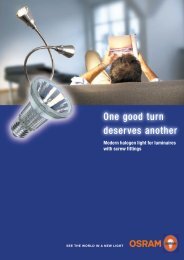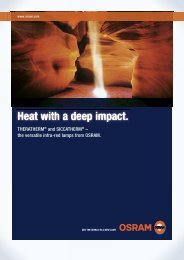Signal lamps - Osram
Signal lamps - Osram
Signal lamps - Osram
Create successful ePaper yourself
Turn your PDF publications into a flip-book with our unique Google optimized e-Paper software.
Lamps for road traffic<br />
signalling equipment<br />
Compared with highvoltage<br />
<strong>lamps</strong>, lowvoltage<br />
overpressure<br />
signal <strong>lamps</strong> have a<br />
considerably higher<br />
luminous efficacy. This<br />
is due to the higher gas<br />
pressure and the inert<br />
filler gas<br />
Permitted<br />
burning position<br />
s 135 2/3)<br />
4)<br />
Product reference Product number<br />
Low voltage for 10V technology in installations to DIN 67527, Part 1<br />
SIG 1227 4050300235028 10.5 22 270 BA20s 36 67 31 1 100/200<br />
SIG 1238 4050300253091 10.5 30 400 BA20s 36 67 31 1 100/200<br />
SIG 1259 4050300831770 10.5 45 600 BA20s 36 67 31 1 100/200<br />
Low voltage LONGLIFE for 10V technology in installations to DIN 67527, Part 1<br />
SIG 1227 LL 4050300900179 10.5 22 270 BA20s 36 67 31 1 100/200<br />
SIG 1238 LL 4050300790503 10.5 30 400 BA20s 36 67 31 1 100/200<br />
Low-voltage overpressure<br />
<strong>lamps</strong> for 10V systems<br />
Low-voltage overpressure<br />
signal <strong>lamps</strong> have a much<br />
higher luminous efficacy than<br />
high-voltage signal <strong>lamps</strong>.<br />
This is due to the higher gas<br />
pressure and the inert filler<br />
gas. The larger diameter of<br />
the tungsten wire of the lowvoltage<br />
filament also helps<br />
increase efficiency. This<br />
means that low-voltage overpressure<br />
<strong>lamps</strong> with significantly<br />
lower wattages can<br />
often be used, with a resultant<br />
reduction in the power consumption<br />
of the signalling<br />
equipment. The filament wire<br />
is more stable than in the<br />
HV lamp, which means that<br />
resistance to shocks and<br />
vibration is particularly high.<br />
The failure rate for standard<br />
10V low-voltage overpressure<br />
<strong>lamps</strong> is less than 2% within<br />
the first 4,400 hours of operation<br />
1) .<br />
These benefits can also be put<br />
to use in existing 230V signalling<br />
installations as it is possible<br />
to convert mains voltage<br />
installations to 10V technology.<br />
The lamp and reflector<br />
have to be replaced and a<br />
transformer installed.<br />
Low-voltage LONGLIFE<br />
<strong>lamps</strong> for 10V systems<br />
The old low-voltage signal<br />
lamp has now been further<br />
developed into a LONGLIFE<br />
lamp. With these <strong>lamps</strong>, a<br />
failure rate of 2% is not<br />
exceeded in the first 8,000<br />
hours 1) . With these <strong>lamps</strong><br />
therefore the maintenance<br />
interval may be up to one year<br />
(depending on the installation).<br />
This means that the advantages of<br />
low-voltage technology are now<br />
available in mains voltage<br />
installations<br />
1) The premature failure rate is restricted to cases that are due to lamp faults and not to external<br />
influences<br />
2) Lamps with transverse filaments should only be inclined perpendicular to the filament plane<br />
3) The <strong>lamps</strong> must be installed only in the burning positions specified. Any other burning positions<br />
will lead to premature failure of the lamp. The abbreviations indicate the main burning position<br />
and the permitted angle in degrees. Main burning positions: s = standing (vertical), base down<br />
4) LCL = light centre length (distance from the coil to top of base)<br />
14


